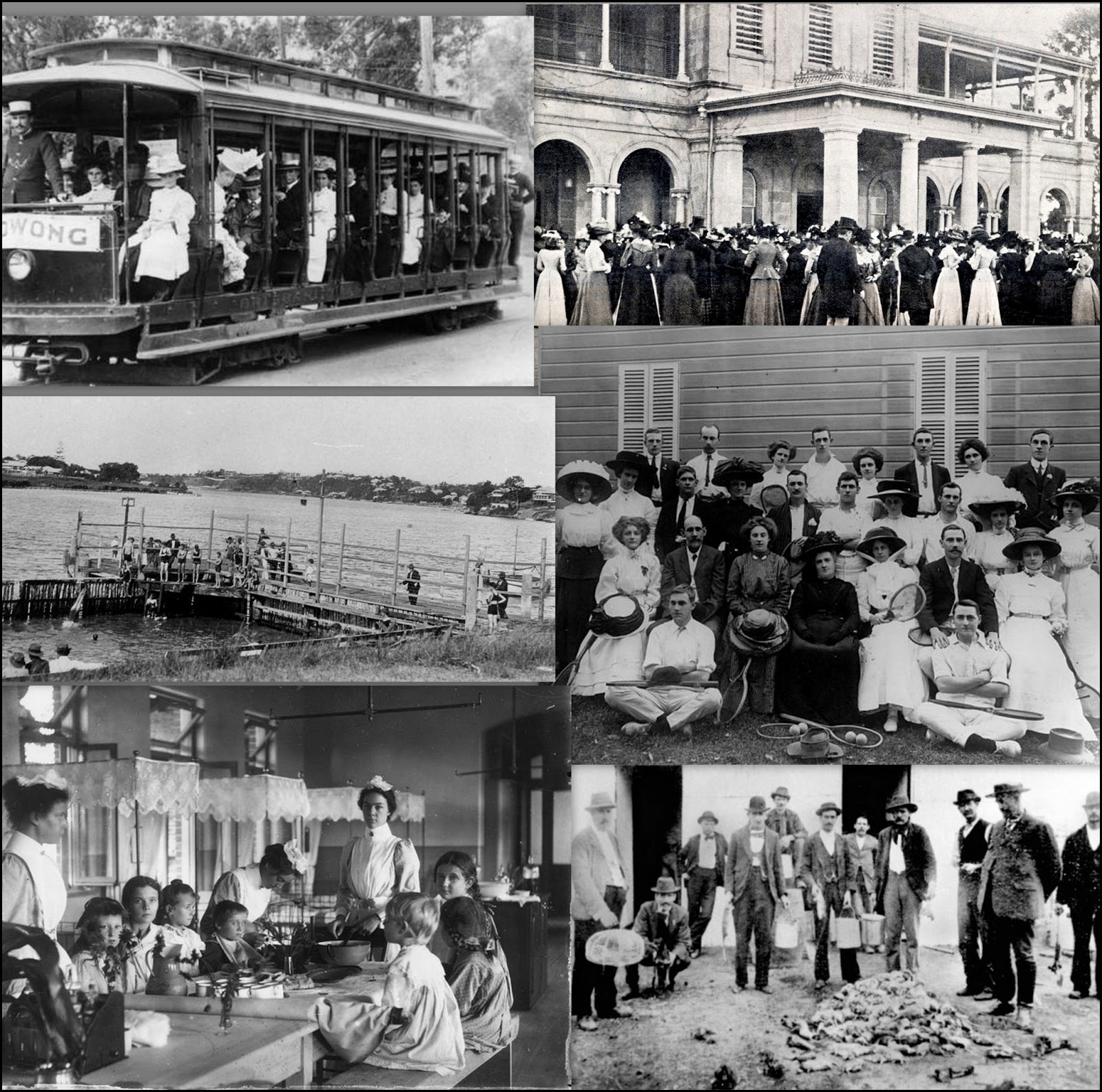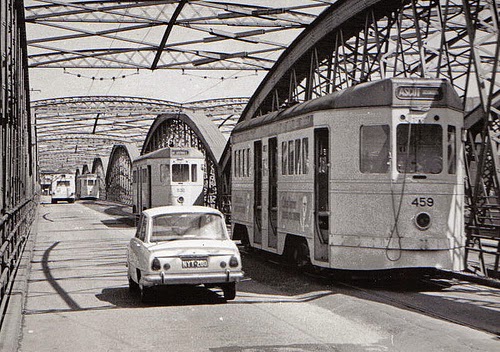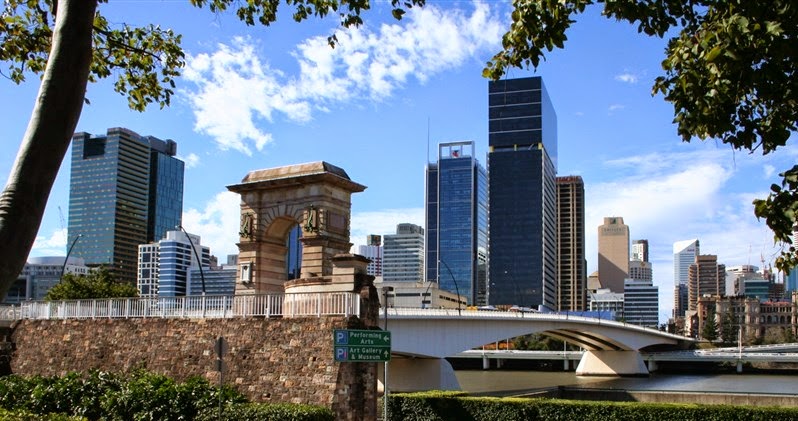4 & FINAL: LAYING QUEEN ST’S GHOSTS TO REST
CIRCA 1900 WHEN BRISBANE MARCHED TO A
DIFFERENT TUNE
While favoured members of Brisbane’s elite mingled on the lawn of Government
House, the Toowong tram carried revellers home to the suburbs…
The swimming enclosure on the river at Mowbray
Park as you can see was well patronised…and a few suburbs across in Clayfield
the local tennis club posed for the camera, racquets in hand…
And while these prim and proper young nurses
at the Brisbane hospital were tending their youngest patients, Brisbane’s rat
catchers were sombrely displaying their days catch, a sobering moment in our
history – Bubonic Plague was terrorising the town.
In a moment reminiscent of Africa’s current Ebola
plague Brisbane doctors improvise their safety gear. An entire street in Brisbane suburb of
Woolloongabba is fenced off and placed in quarantine following a resident’s diagnosis
of plague.
***
BUT NOT ALL WAS DOOM AND GLOOM
1901 BRISBANE CELEBRATES
AS
AUSTRALIA BECOMES A COMMONWEALTH
 1900-1910: Unbelievably
Queen Victoria’s 62 year reign over her
dominions has encompassed almost the entire lifetime of Brisbane’s main
thoroughfare: Women are demanding their voting rights, Australian troops have
been sent to fight the Boers in South Africa:
Horse drawn trams have finally given way to electric powered
carriages...and in 1901 Brisbane crowds mass in Queen Street to celebrate
Federation Day.
1900-1910: Unbelievably
Queen Victoria’s 62 year reign over her
dominions has encompassed almost the entire lifetime of Brisbane’s main
thoroughfare: Women are demanding their voting rights, Australian troops have
been sent to fight the Boers in South Africa:
Horse drawn trams have finally given way to electric powered
carriages...and in 1901 Brisbane crowds mass in Queen Street to celebrate
Federation Day.
*
Again: A favourite photographers spot, Queen Street
near the intersection with Edward.
With decorated arches and marching bands, swirling
flags and colourful bunting Brisbane is out in force to celebrate Federation.
With no TV or radio, nor mobile phones or
sensational Murdoch style press to spread the word, advertise the event, the
city centre is still shoulder to shoulder jam packed with Brisbane’s entire
population plus a good deal more trained in from the country. Entertainment back
then was hands on, word of mouth enjoyed by a mob of well behaved though
excited observers.
*
They line the street, climb out onto shop
awnings, wave patriotic flags and noisily make their presence felt. The
imposing, though only partially built Treasury Building is the backdrop for
this official ceremony on 1st January 1901 marking the proclamation
of the Federation of Australia by Queensland’s Governor, Baron Lamington.
The vice regal party can be seen on the suitably
decorated balcony fronting William Street with its view across the river: the
Governor standing in for the absent and far away Queen Victoria.
None
could guess the venerable old lady’s death is only 22 days away.
*
In the shot above the camera man has moved
round the corner into Queen Street, at this stage it’s still evident the
partially completed Treasury’s Queen Street façade has a long way to go.
*
Further along Queen Street.: The Royal Lancers
leading the Federation Day Parade…
…. And next, perhaps just an hour or so later,
the parade has ended, the crowd have spilled out into that same part of Queen
Street; traffic is at a standstill, the city still awash with celebration.
Look carefully at those two photos, the one
above and the one before, both taken at the very same spot in Queen Street. The
imposing building midway along on the left is the old National Bank, now
housing a fashion boutique.
*
Those
first town planners must rue the day they quibbled over the width of a street,
nowhere is their narrow mindlessness more evident than on occasions like this
when Queen Street becomes an impenetrable mass of bodies.
***
JUMP 15 YEARS
By the time this next photo is taken years
have passed. The Treasury’s Queen St frontage completed; its façade much as it
appears today, there is though, a great deal of work still to be done on the
invisible Elizabeth Street side.
For a while until the
stone work becomes weathered by rain and wind, as this early photo shows only
too well, the contrast between the first built section and the more recent is
considerable. In this picture the
weathered sandstone approach to the new double lane Victoria Bridge is just in
view, with 1915’S motor vehicles swinging across into William Street.
*
Nowadays in the 21st Century the same
building is better known as the Treasury Casino where spirits of a different
sort are most certainly imbibed.
*
WAR AND WOMENS LIB
Drop back a wee bit to 1900: Australian women reluctantly
send their men off to a war in far away South Africa. The photo below predating
the Federation celebrations shows Queen Street and the corner of Albert
thronged with crowds cheering troops bound for the Boer War. It’s not the first
time Aussie boys have been sent overseas to fight for King and country and sadly
it won’t be the last.
Aussie soldiers were first deployed overseas
to the Sudan in 1885 following the death of General Gordon in Khartoum.
In the same photo focus further past the
mounted soldiers towards the Edward Street intersection where you can see
horseless trams banked up behind the procession: Electricity is the buzz word of the day, but
who back then could imagine the glittering neon throbbing Mall this part of
Queen Street would one day become?
*
1907: A MILESTONE FOR WOMEN
For the fair sex it has been a long battle, but the
photo of this lone Brisbane woman in the midst of male compatriots says it
all. She has at last won the right to
enter that bastion of male decision makers, the voting booth.
*
1912 BRISBANE COMES TO A STANDSTILL
NO TRAINS – NO TRAMS
Queensland’s rail service began in 1865; not in the
State’s capital, but in nearby Ipswich, the opening ceremony attended by ladies
in voluminous crinolines.
A few years later a line was opened to
Brisbane, and very soon branch lines began spreading to outer suburbs.
The steam train, or puffing billy’s as their smoke
stacks indicated only too well played a huge part in shifting Brisbane’s
population from country and rural suburbs to the city centre. Exteriors of Central and South Brisbane
station have changed very little, but who would recognize the Roma Street
Station of the early 1900’s? It looked
more like a stately manor house.
These three stations along with trams and
buses will soon become the focal point of a major dispute when Brisbane traffic
is crippled by a world first – a united transport workers strike.
***
SOLIDARITY
The women in the photo below seen stepping out
proudly in their Sunday best, march full of confidence and so they should: They
have after all achieved liberation and a voting right denied them for so long …
but as they blithely march seemingly intent solely on the job at hand, each and
every one of them has no idea a brutal, bloody world war is only a few years
away. No idea at all the scope of
suffering and loss that will surely make their present cause seem trivial and
inconsequential to the extreme.
The strike and resulting demonstrations
started with a dispute over the right to wear a union badge then escalated to
the basic right to join a union. Brisbane women had gained their voting rights
five years earlier and were now marching through city streets in solidarity
with their menfolk.
Did
I mention the ladies marching included young girls and even elderly
grandmothers? One in particular will
achieve lifelong notoriety and even hero worship before the dispute is finally
settled.
The women’s striking husbands, fathers,
brothers meanwhile were massing a few blocks away in Market Square, now King George Square, right
outside the old Tivoli Theatre. (But not in front of Brisbane’s City Hall
because at this stage it hasn’t yet been built.)
Even though tram and train drivers had walked out
and public transport was at a standstill the Government of the day banned
processions after taking the incredible step of issuing bayonets to the police
force and even swearing in special constables…evident in the picture above.
This photo taken in front of Finney’s in Queen
Street features a requisitioned tram and the horse and buggy beside it moving
police officers and special constables between the city and Fortitude Valley.
The watching crowd denied the right to protest appear wary.
More hands on activity however was taking
place in George Street in front of Parliament House where the lady pictured below
has taken up her stance.
This elderly Brisbane Grandmother, Emma
Miller, 73 years old, only 4 feet 11 inches tall, a women’s rights and labour
activist will soon claim her place in Brisbane’s Black Friday history. At the height of the demonstrations when
confronted by the law, she takes a hatpin from her fashionable bonnet and
sticks it into the rump of the horse ridden by the Police Commissioner.
The horse of course reared and the gentleman
was thrown to the ground and consequently injured…though not seriously.
And Emma became an instant heroine of the
Union movement.
There’s
a lot more history attached to Emma Miller, she deserves a story line to
herself…perhaps later in the year.
***
1914: WAR, like rain and
flood seemed always to hover.
The Commonwealth’s worst fears have been
realised. With the advent of WW1, the march past of troops heading overseas becomes
more frequent. The crowds are quieter,
more reserved. The atmosphere is one of
fidelity and loyalty to Mother England but at what dire cost?
News from England and Europe is sobering. In
Australian homes dreaded telegrams are becoming more prevalent.
Soldiers of the 9th Battalion wearing
white emu feathers on their slouch hats pass along Queen Street. Teenage school
boys watching from the crowd easily identified in their white straw boater hats
are probably looking on with envy: Hero worship of men with guns.
But before this war, supposedly the war to end
all wars finally ends, some of these boys will themselves be marching off to battle,
and like the soldiers they’re watching now, striding along in smart formation,
many of them will not come home; ever.
1916:
WW1 shows no signs of abating. Brisbane crowds gather to cheer the boys of the
41st Battalion.
Marching four abreast, the long line of khaki
uniforms stretch the entire length of Queen Street. How many I wonder survived
to join the ensuing Peace Parade of 1919 shown next.
1940: A GENERATION LATER
ANOTHER WAR
And
yes, this is the same much photographed section of Queen Street captured so
often in earlier photos.
Brisbane some 35 years after
WW1 - not a great deal has changed apart from women’s fashion; even the enemy
is the same as Brisbane gathers again to support their boys, this time the 7th
Australian Division as they march off to fight yet another war on foreign soil.
***
LIFE GOES ON
TODAY: BRISBANE A MODERN CITY
IN
THE MIDST OF A TWISTING FLOOD PRONE RIVER
The small settlement intended only as a convict
prison has grown to an enormous size. The population has swelled and now in the
2014’s the central Queen Street area of Brisbane has pushed its perimeters up,
up into the sky. A few grand old
buildings have survived: they still dot
the CBD streets, their historical value at last recognized and preserved.
Modern Brisbane has
caught up with southern sisters, Sydney and Melbourne: South Brisbane has become the museum, art
gallery and performing arts hub of the river’s south bank. Queen Street no
longer a traffic thoroughfare linking north to south is now a glittering
pedestrian mall thronged day and night with a passing parade of shoppers and
office workers.
Gone from sight and mind are
the everyday remnants of times past, the quaint corner pubs, the butchers with
their sides of beef and lamb hanging in window fronts, the horse and cart
trotting by on muddy streets, the sweeping gowns, the days of parasols and
moustachioed gentlemen.
Go back through this four
part series, view again the transformation of a small insignificant collection
of convict gaols and flimsy huts into this busy pulsing metropolis and become
enraptured with these people from our past… let your mind wander back in time
and you will see and hear them as surely as if you were there, treading in your
ancestors footsteps.
***
BOTH QUEEN STREET AND THE RIVER rushing by
were old Brisbane’s major thoroughfares. The river though, and the eternal problem of flood proofing the Victoria Bridge
seemed always to be a constant thorn in the best laid plans of a succession of
city fathers.
Eventually the river will be spanned by no
less than 12 bridges, both pedestrian, traffic and rail but all that will take
place in a far distant future.
***
VICTORIA BRIDGE in all its previous and
present persona tells best the story of Queen Streets evolution. After all where street meets river man must
provide a way across. The photos show
the doggedness of early developers, the triumph over flood.
First there was the temporary bridge joining
the town centre to South Brisbane. Worm
rot and flood brought that one down and tenders were called to erect a more
substantial version. I guess authorities
rather hoped they had the problem solved with this single lane iron bridge shown
below.
But they hadn’t bargained for the Great Flood
of 1893 which ultimately left Brisbane with only half a bridge, and South
Brisbane minus their piped water supply.
For the next four years passengers and goods will
be carried back and forth by barge and ferry until 1897 when the new Victoria
Bridge, a grand steel version with two carriage ways and two footpaths is
finally completed.
This graceful arched bridge will outlast the
horse and buggy, usher in the advent of modern motorised transport, see the
start and finish of WW2 and continue in service until 1969 when it will be
honourably retired and replaced with the sleek modern version in use today.
It’s not until you view Victoria Bridge in all
its previous guises that you realise its ongoing role in the history of Queen
Street. While The City itself was undergoing it’s
metamorphose from village to metropolis,
Brisbane’s Victoria Bridge was doggedly keeping pace, constantly
adapting and changing its width and strength to accommodate the gradual switch
from horse and buggy to motor vehicle and tram.
Some of you may not remember Brisbane’s trams;
your mothers, fathers and grandparents most certainly will. Their banishing
from Brisbane’s streets go hand in hand with the demise of Cloudland and the
historic Bellevue Hotel.
***
LAYING THE GHOSTS TO REST
Victoria Bridge in all its various persona, down through the years has carried and been privy to the dreams and aspirations of a succession of Brisbane’s inhabitants. We’ve walked across the river pausing to watch the ebb and tidal flow below, we’ve watched its demise from the river bank, we’ve ridden across in cars and buses, we’ve sat perched in the back of modest drays and trotted along smartly on high stepping horses: Street and bridge, trusted holders of secrets and whispers, the musings of ghosts from our past.
*
But Brisbane’s old and venerable Victoria
Bridge, solid and long lasting as it was, when finally pulled down and
relegated to land fill, did leave behind a ghostly reminder of those earlier
days.
A portion of the stately carved stone approach
was left standing as a glorious memorial commemorating the untimely death of an
11 year old boy of Greek heritage, Hector Vasyli; killed in a motor accident on
the bridge in 1918 while welcoming home soldiers returning from the war.
|
Young Hector’s spirit in step with countless
pedestrians and passengers has overseen the life and times of nearly a hundred
years: The gradual addition of high rise
buildings reaching to the sky, the subdued design of the new modern bridge, the
passing parade of historical change.
And maybe his spirit keeps company with all
the other souls that came before him, the soldiers marching off to war,
wretched convicts and pioneering settlers, all the city’s original inhabitants
from earlier times who left behind a multitude of footprints imprinted along a
simple muddy track that came to be known as Queen Street.
Listen
carefully for their whispers when you cross that new bridge and walk through
the mall, listen to the Ghosts of Queen Street past, clamouring only to be
remembered.
***
Heartfelt
thanks to the many unknown photographers who left their work to posterity and
to the faceless people behind the Archives who preserve and safeguard these
collections. Without their dedication
our children and their children would never discover much less appreciate their
hard fought heritage.
Robyn Mortimer – Concept
and Storyline ©2014
Part 1.
Part 2.
Part 3.






















.jpg)








No comments:
Post a Comment
I love hearing from you, your comments good, bad or indifferent are always welcome..your anonymity will be respected. But remember if you want me to reply you will need to supply a contact email address otherwise I will never know who you are.